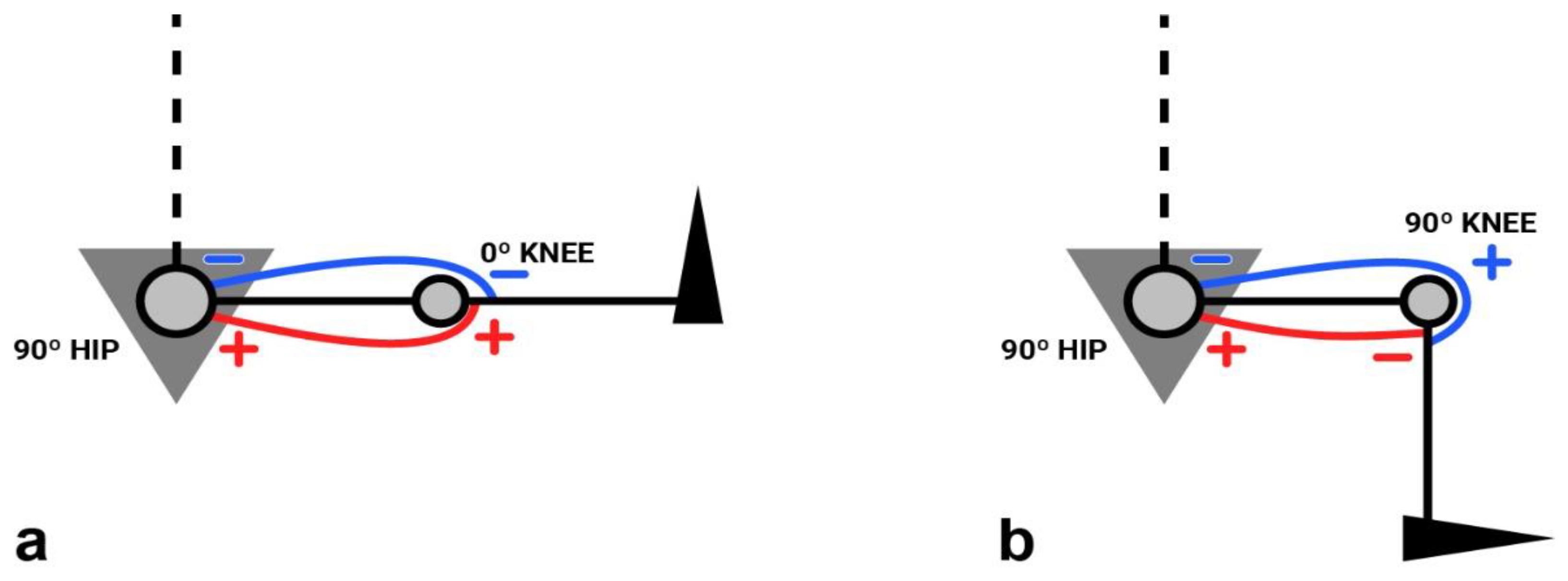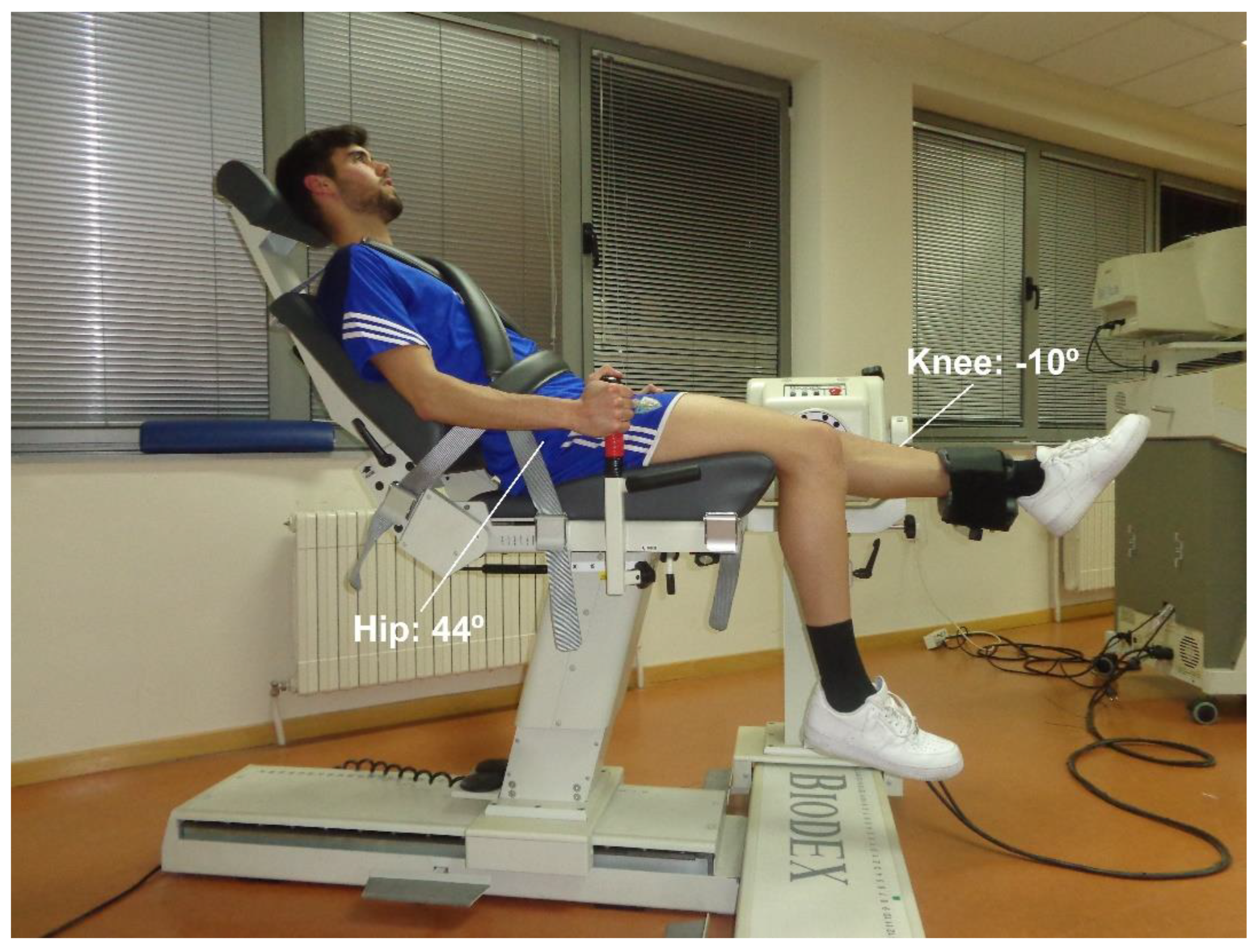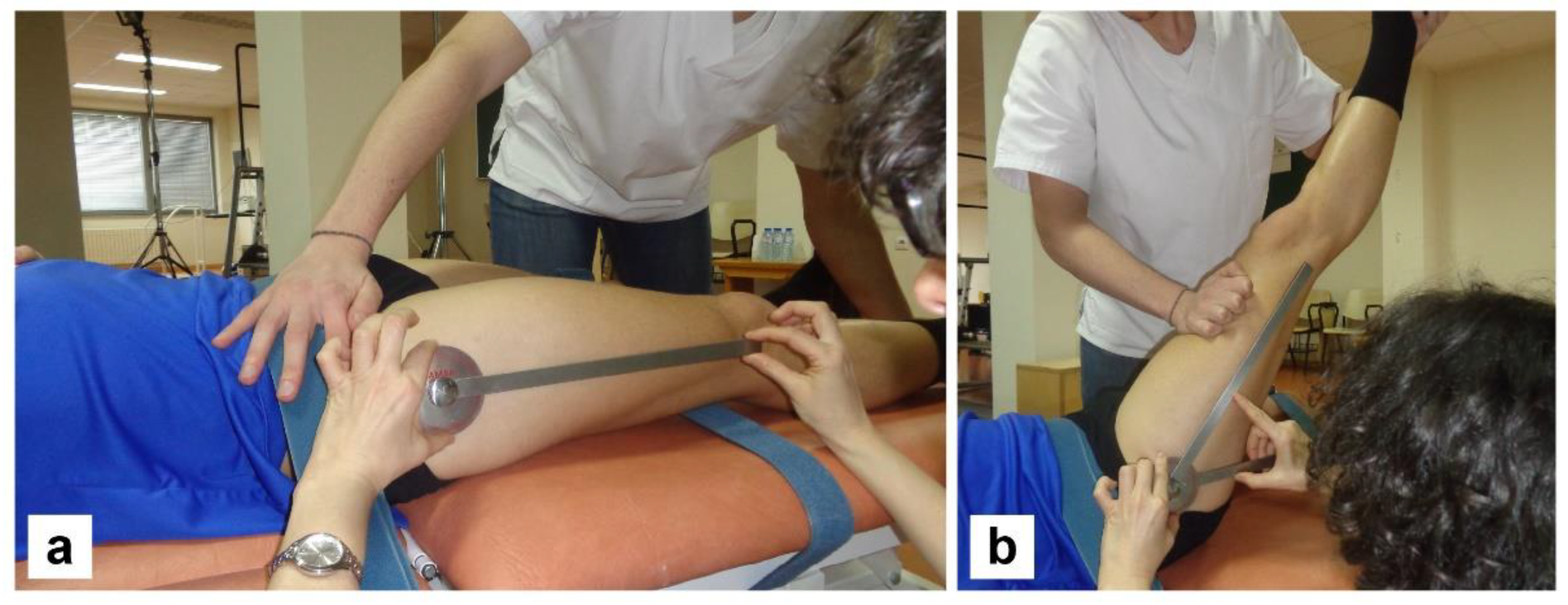Comparison of the Agonist/Antagonist Tensional Balance of the Knee between Two Isokinetic Positions: A Pilot Study on a Sample of High-Level Competitive Soccer Players
Abstract
:1. Introduction
2. Materials and Methods
2.1. Experimental Approach to the Problem
2.2. Subjects
2.3. Procedures
2.4. Statistical Analyses
3. Results
4. Discussion
5. Conclusions
Author Contributions
Funding
Institutional Review Board Statement
Informed Consent Statement
Data Availability Statement
Acknowledgments
Conflicts of Interest
Appendix A
| Subjects | Hamstring Elasticity (°) | Hamstring Peak Torque | ||||||
|---|---|---|---|---|---|---|---|---|
| Classic Sitting Position (CSP) | Unified Reclined Position URP) | |||||||
| Dom | N-Dom | HEXC30 (Nm) | Asym (%) | HEXC30 (Nm) | Asym (%) | |||
| 1 | 82 | 84 | 162.3 | 141.8 | 12.7 * | 159.7 | 166.2 | 4 |
| 2 | 69 * | 69 * | 163.7 | 140.7 | 14 * | 151 | 139.4 | 7.7 |
| 3 | 52 * | 60 * | 141.6 | 142.1 | 4 | 153.7 | 122.7 | 20.2 * |
| 4 | 84 | 72 * | 156.7 | 138.7 | 11.5 * | 142.6 | 151 | 5.9 |
| 5 | 82 | 114 | 203.6 | 160.7 | 21 * | 171.5 | 178.8 | 4.3 |
| 6 | 105 | 119 | 166.8 | 132.4 | 20.6 * | 128.5 | 109.9 | 14.5 * |
| 7 | 60 * | 65 * | 140.3 | 160.3 | 14.2 * | 140.9 | 140.3 | 0.4 |
| 8 | 90 | 100 | 147.9 | 181.7 | 22.8 * | 168 | 186.5 | 11 * |
| 9 | 73 * | 77 * | 153.4 | 126.4 | 17.6 * | 160 | 122.1 | 23.7 * |
| 10 | 78 * | 64 * | 169.6 | 147.3 | 13.1 * | 185.3 | 155.4 | 16.2 * |
| 11 | 90 | 80 | 127.8 | 128.7 | 0.7 | 114.7 | 111.4 | 2.9 |
| 12 | 54 * | 60 * | 134.2 | 124.8 | 7 | 126.5 | 113 | 10.7 * |
| 13 | 65 * | 78 * | 150.1 | 136.9 | 8.8 | 137.2 | 155.6 | 13.4 * |
| 14 | 78 * | 80 | 193.1 | 177.9 | 7.8 | 175.8 | 172.5 | 1.8 |
| 15 | 95 | 85 | 125.1 | 135.7 | 8.4 | 100.1 | 133.2 | 33 * |
| 16 | 68 * | 78 * | 112.4 | 151.4 | 34.6 * | 120.6 | 96.8 | 19.7 * |
| 17 | 78 * | 89 | 156.1 | 152.9 | 2 | 148 | 145.6 | 1.6 |
| 18 | 50 * | 50 * | 137.1 | 146.7 | 7 | 119.3 | 145.1 | 21.6 * |
| 19 | 69 * | 60 * | 161.8 | 147.5 | 8.9 | 165 | 143.7 | 12.9 * |
| 20 | 60 * | 63 * | 127.3 | 124.9 | 1.9 | 130.4 | 150.7 | 15.6 * |
| Subjects | Conventional Ratio (HCON60/QCON60) | Functional Ratio (HEXC30/QCON240) | ||||||
|---|---|---|---|---|---|---|---|---|
| Classic sitting Position (CSP) | Unified Reclined Position (URP) | Classic Sitting Position (CSP) | Unified Reclined Position (URP) | |||||
| Dom Leg | N-Dom Leg | Dom Leg | N-Dom Leg | Dom Leg | N-Dom Leg | Dom Leg | N-Dom Leg | |
| 1 | 57.7 * | 52.9 * | 47.7 * | 47.4 * | 128.4 | 113.5 | 123.2 | 120.0 |
| 2 | 72.8 | 62.1 | 77.2 | 54.5 * | 161.0 | 137.0 | 172.0 | 114.0 |
| 3 | 64.2 | 56.6 * | 56.3 * | 55.6 * | 114.1 | 114.0 | 118.1 | 88.0 ** |
| 4 | 62.8 | 50.9 * | 63.7 | 57.2 * | 121.0 | 108.2 | 119.4 | 107.9 |
| 5 | 58.2 * | 53.2 * | 58.8 * | 59.8 * | 125.2 | 104.8 | 112.6 | 121.6 |
| 6 | 50.8 * | 51.6 * | 78.7 | 69.2 | 191.9 | 138.5 | 150.6 | 110.6 |
| 7 | 60.3 | 53.9 * | 56.9 * | 61.7 | 138.1 | 161.9 | 125.2 | 137.8 |
| 8 | 60.6 | 52.2 * | 55.1 * | 59.1 * | 125.0 | 116.7 | 95.6 ** | 129.2 |
| 9 | 51.4 * | 43.9 * | 55.2 * | 48.6 * | 104.4 | 94.9 ** | 120.1 | 84.9 ** |
| 10 | 65.0 | 57.2 * | 67.3 | 62.3 | 116.0 | 110.2 | 123.9 | 108.1 |
| 11 | 55.6 * | 59.7 * | 59.3 * | 53.1 * | 134.0 | 148.1 | 143.2 | 150.5 |
| 12 | 57.4 * | 42.1 * | 62.3 | 51.1 * | 119.2 | 109.7 | 100.7 | 106.0 |
| 13 | 61.9 | 59.8 * | 51.7 * | 56.8 * | 159.7 | 155.2 | 189.8 | 203.9 |
| 14 | 66.9 | 124.9 | 69.0 | 110.4 | 170.4 | 206.9 | 174.1 | 230.0 |
| 15 | 59.3 * | 95.9 | 64.1 | 82.2 | 124.0 | 144.2 | 120.9 | 179.5 |
| 16 | 52.0 * | 57.7 * | 54.5 * | 61.7 | 94.5 ** | 131.4 | 98.5 | 88.2 ** |
| 17 | 62.3 | 57.3 * | 56.3 * | 58.9 * | 146.2 | 129.7 | 140.7 | 123.9 |
| 18 | 79.2 | 97.9 | 77.9 | 77.5 | 99.3 | 117.6 | 95.0 ** | 119.8 |
| 19 | 58.1 * | 46.3 * | 57.7 * | 53.4 * | 111.4 | 116.4 | 110.6 | 109.7 |
| 20 | 52.7* | 61.5 | 51.1 * | 66.3 | 115.9 | 113.6 | 122.9 | 176.3 |
References
- Jegu, A.-G.; Pereira, B.; Andant, N.; Coudeyre, E. Effect of eccentric isokinetic strengthening in the rehabilitation of patients with knee osteoarthritis: Isogo, a randomized trial. Trials 2014, 15, 106. [Google Scholar] [CrossRef] [PubMed] [Green Version]
- Śliwowski, R.; Jadczak, Ł.; Hejna, R.; Wieczorek, A. The effects of individualized resistance strength programs on knee muscular imbalances in junior elite soccer players. PLoS ONE 2015, 10, e0144021. [Google Scholar] [CrossRef] [PubMed]
- Hägglund, M.; Waldén, M.; Ekstrand, J. Risk factors for lower extremity muscle injury in professional soccer: The UEFA Injury Study. Am. J. Sports Med. 2013, 41, 327–335. [Google Scholar] [CrossRef] [PubMed] [Green Version]
- Arnason, A.; Sigurdsson, S.B.; Gudmundsson, A.; Holme, I.; Engebretsen, L.; Bahr, R. Risk factors for injuries in football. Am. J. Sports Med. 2004, 32, 5–16. [Google Scholar] [CrossRef]
- Orchard, J.; Marsden, J.; Lord, S.; Garlick, D. Preseason hamstring muscle weakness associated with hamstring muscle injury in Australian footballers. Am. J. Sports Med. 1997, 25, 81–85. [Google Scholar] [CrossRef] [PubMed]
- Orchard, J.; Seward, H. Epidemiology of injuries in the Australian Football League, seasons 1997–2000. Br. J. Sports Med. 2002, 36, 39–44. [Google Scholar] [CrossRef] [PubMed] [Green Version]
- Dauty, M.; Potiron-Josse, M.; Rochcongar, P. Consequences and prediction of hamstring muscle injury with concentric and eccentric isokinetic parameters in elite soccer players. Ann. Réadaptation Médecine Phys. 2003, 46, 601–606. [Google Scholar] [CrossRef]
- Houweling, T.A.W.; Head, A.; Hamzeh, M.A. Validity of isokinetic testing for previous hamstring injury detection in soccer players. Isokinet. Exerc. Sci. 2009, 17, 213–220. [Google Scholar] [CrossRef]
- Graham-Smith, P.; Jones, P.A.; Comfort, P.; Munro, A.G. Assessment of knee flexor and extensor muscle balance. Int. J. Athl. Ther. Train. 2013, 18, 1–5. [Google Scholar] [CrossRef]
- Coombs, R.; Garbutt, G. Developments in the use of the hamstring/quadriceps ratio for the assessment of muscle balance. J. Sports Sci. Med. 2002, 1, 56–62. [Google Scholar]
- Lehnert, M.; Xaverová, Z.; Croix, M.D.S. Changes in Muscle Strength in U19 Soccer Players during an Annual Training Cycle. J. Hum. Kinet. 2014, 42, 175–185. [Google Scholar] [CrossRef] [PubMed] [Green Version]
- Aagaard, P.; Simonsen, E.B.; Trolle, M.; Bangsbo, J.; Klausen, K. Isokinetic hamstring/quadriceps strength ratio: Influence from joint angular velocity, gravity correction and contraction mode. Acta Physiol. Scand. 1995, 154, 421–427. [Google Scholar] [CrossRef] [PubMed]
- Aagaard, P.; Simonsen, E.B.; Magnusson, S.P.; Larsson, B.; Dyhre-Poulsen, P. A new concept for isokinetic hamstring: Quadriceps muscle strength ratio. Am. J. Sports Med. 1998, 26, 231–237. [Google Scholar] [CrossRef] [PubMed]
- Croisier, J.-L.; Forthomme, B.; Namurois, M.-H.; Vanderthommen, M.; Crielaard, J.-M. Hamstring muscle strain recurrence and strength performance disorders. Am. J. Sports Med. 2002, 30, 199–203. [Google Scholar] [CrossRef] [PubMed]
- Thelen, D.G.; Chumanov, E.S.; Best, T.M.; Swanson, S.C.; Heiderscheit, B.C. Simulation of biceps femoris musculotendon mechanics during the swing phase of sprinting. Med. Sci. Sport Exerc. 2005, 37, 1931–1938. [Google Scholar] [CrossRef] [Green Version]
- Yu, B.; Queen, R.M.; Abbey, A.N.; Liu, Y.; Moorman, C.T.; Garrett, W.E. Hamstring muscle kinematics and activation during overground sprinting. J. Biomech. 2008, 41, 3121–3126. [Google Scholar] [CrossRef]
- Croisier, J.-L.; Ganteaume, S.; Binet, J.; Genty, M.; Ferret, J.-M. Strength imbalances and prevention of hamstring injury in professional soccer players: A prospective study. Am. J. Sports Med. 2008, 36, 1469–1475. [Google Scholar] [CrossRef]
- Ayala, F.; de Baranda, P.; Cejudo, A.; Santonja, F. Angular tests for estimating hamstring flexibility: Description of their measurement method and reference values. Rev. Andal. Med. Deporte 2013, 6, 120–128. [Google Scholar] [CrossRef] [Green Version]
- Ayala, F.; de Baranda, P.S.; de Ste Croix, M.; Santonja, F. Validity and reliability of isokinetic strength ratios for estimating muscle imbalances. Apunt. Sports Med. 2012, 47, 131–142. [Google Scholar]
- Deighan, M.A.; Serpell, B.G.; Bitcon, M.J.; Croix, M.D.S. Knee joint strength ratios and effects of hip position in Rugby players. J. Strength Cond. Res. 2012, 26, 1959–1966. [Google Scholar] [CrossRef]
- Magnusson, S.P.; Geismar, R.A.; Gleim, G.W.; Nicholas, J.A. The effect of stabilization on isokinetic knee extension and flexion torque production. J. Athl. Train. 1993, 28, 221–225. [Google Scholar] [PubMed]
- Koutras, G.; Bernard, M.; Terzidis, I.P.; Papadopoulos, P.; Georgoulis, A.; Pappas, E. Comparison of knee flexion isokinetic deficits between seated and prone positions after ACL reconstruction with hamstrings graft: Implications for rehabilitation and return to sports decisions. J. Sci. Med. Sport 2016, 19, 559–562. [Google Scholar] [CrossRef] [PubMed]
- Kellis, E.; Ellinoudis, A.; Kofotolis, N. Effect of Hip Flexion Angle on the Hamstring to Quadriceps Strength Ratio. Sports 2019, 7, 43. [Google Scholar] [CrossRef] [PubMed] [Green Version]
- Guex, K.; Gojanovic, B.; Millet, G.P. Influence of hip-flexion angle on hamstrings isokinetic activity in sprinters. J. Athl. Train. 2012, 47, 390–395. [Google Scholar] [CrossRef] [PubMed] [Green Version]
- Sánchez, W.G.; Alzate, S.J.; Gómez, D.A.; Quiceno, B.H. Gesto técnico del pateo a balón detenido en fútbol: Estudio de caso, un análisis comparativo en 3D. VIREF Rev. Educ. Física 2018, 7, 15–35. [Google Scholar]
- Witvrouw, E.; Danneels, L.; Asselman, P.; D’Have, T.; Cambier, D. Muscle flexibility as a risk factor for developing muscle injuries in male professional soccer players. A prospective study. Am. J. Sports Med. 2003, 31, 41–46. [Google Scholar] [CrossRef]
- Gür, H.; Akova, B.; Pündük, Z.; Küçükoğlu, S. Effects of age on the reciprocal peak torque ratios during knee muscle contractions in elite soccer players. Scand. J. Med. Sci. Sports 1999, 9, 81–87. [Google Scholar] [CrossRef]
- Tourny-Chollet, C.; Leroy, D.; Léger, H.; Beuret-Blanquart, F. Isokinetic knee muscle strength of soccer players according to their position. Isokinet. Exerc. Sci. 2000, 8, 187–193. [Google Scholar] [CrossRef]
- Tyler, T.F.; Schmitt, B.M.; Nicholas, S.J.; McHugh, M.P. Rehabilitation after hamstring-strain injury emphasizing eccentric strengthening at long muscle lengths: Results of long-term follow-up. J. Sport Rehabil. 2017, 26, 131–140. [Google Scholar] [CrossRef]
- Bohannon, R.W.; Gajdosik, R.L.; LeVeau, B.F. Isokinetic knee flexion and extension torque in the upright sitting and semireclined sitting positions. Phys. Ther. 1986, 66, 1083–1086. [Google Scholar] [CrossRef]
- Barr, A.E.; Duncan, P.W. Influence of position on knee flexor peak torque. J. Orthop. Sport Phys. Ther. 1988, 9, 279–283. [Google Scholar] [CrossRef] [PubMed]
- Lin, C.-F.; Liu, H.; Gros, M.T.; Weinhold, P.; Garrett, W.E.; Yu, B. Biomechanical risk factors of non-contact ACL injuries: A stochastic biomechanical modeling study. J. Sport Health Sci. 2012, 1, 36–42. [Google Scholar] [CrossRef] [Green Version]
- van der Horst, N.; Smits, D.-W.; Petersen, J.; Goedhart, E.A.; Backx, F.J.G. The preventive effect of the nordic hamstring exercise on hamstring injuries in amateur soccer players: A randomized controlled trial. Am. J. Sports Med. 2015, 43, 1316–1323. [Google Scholar] [CrossRef] [PubMed]
- Worrell, T.W.; Perrin, D.H.; Denegar, C.R. The influence of hip position on quadriceps and hamstring peak torque and reciprocal muscle group ratio values. J. Orthop. Sport Phys. Ther. 1989, 11, 104–107. [Google Scholar] [CrossRef]
- Findley, B.W.; Brown, L.E.; Whitehurst, M.; Keating, T.; Murray, D.P.; Gardner, L.M. The influence of body position on load range during isokinetic knee extension/flexion. J. Sports Sci. Med. 2006, 5, 400–406. [Google Scholar]
- Bogdanis, G.C.; Kalapotharakos, V.I. Knee extension strength and hamstrings-to-quadriceps imbalances in elite soccer players. Int. J. Sports Med. 2016, 37, 119–124. [Google Scholar] [CrossRef]
- Askling, C.; Karlsson, J.; Thorstensson, A. Hamstring injury occurrence in elite soccer players after preseason strength training with eccentric overload. Scand. J. Med. Sci. Sports 2003, 13, 244–250. [Google Scholar] [CrossRef]
- Houtz, S.J.; Lebow, M.J.; Beyer, F.R. Effect of posture on strength of the knee flexor and extensor muscles. J. Appl. Physiol. 1957, 11, 475–480. [Google Scholar] [CrossRef]
- Hedayatpour, N.; Golestani, A.; Izanloo, Z.; Sepehri, A.; Kamali, M. Time to task failure of the contralateral untrained limb after high load-low repetition eccentric and low load-high repetition resistance training. Mot. Rev. Educ. Física 2017, 23, e101619. [Google Scholar] [CrossRef] [Green Version]
- Alt, T.; Richert, M.; Schwarz, Y.M.; Knicker, A.J.; Strüder, H.K. Minimal fixation suffices for supine isokinetic knee extension: A kinetic and 3D kinematic analysis. Isokinet. Exerc. Sci. 2016, 24, 301–311. [Google Scholar] [CrossRef]





| Hamstring Elasticity (°) | Hamstring Peak Torque | ||||||
|---|---|---|---|---|---|---|---|
| Classic Sitting Position (CSP) | Unified Reclined Position (URP) | ||||||
| Dom | N-Dom | HEXC30 (Nm) | Asymmetry (%) | HEXC30 (Nm) | Asymmetry (%) | ||
| 74.1 ± 14.9 | 77.4 ± 18 | Dom leg | N-Dom leg | ER Dom/N-Dom | Dom leg | N-Dom leg | ER Dom/N-Dom |
| 75.7 ± 16.4 * | 152 ± 22.4 | 144 ± 16 | 11.9 ± 8.33 * | 144.9 ± 22.8 | 142 ± 24.2 | 12.1 ± 8.73 * | |
| Quadriceps elasticity: 31.9 ± 8.84 ** | p-value = 0.18 (n.s.) | p-value = 0.52 (n.s.) | |||||
| URP = 75.7° − 31.9° | Dom + N-Dom (n = 40): 148.3 ± 19.5 | Dom + N-Dom (n = 40): 143.5 ± 23.2 | |||||
| URP = 43.8° ≈ 44° | p-value = 0.086 (n.s.) | ||||||
| Dominant Leg: Eccentric Hamstring Peak Torque 30°/s (Hexc30) | |||
|---|---|---|---|
| URP < CSP (n = 12) | CSP < URP (n = 8) | ||
| CSP: 156.4 ± 24.3 | URP: 139.6 ± 23 | CSP: 144.3 ± 18.4 | URP: 153 ± 21.3 |
| p = 0.001 | p = 0.003 | ||
| Conventional Ratio (HCON60/QCON60) | Functional Ratio (HEXC30/QCON240) | ||||||
|---|---|---|---|---|---|---|---|
| Classic Sitting Position (CSP) | Unified Reclined Position (URP) | Classic Sitting Position (CSP) | Unified Reclined Position (URP) | ||||
| Dom leg | N-Dom leg | Dom leg | N-Dom leg | Dom leg | N-Dom leg | Dom leg | N-Dom leg |
| 60.5 ± 7.07 | 61.9 ± 20.6 | 61.0 ± 8.99 | 62.3 ± 14 | 130 ± 24.9 | 129 ± 25.8 | 128 ± 20.6 | 130 ± 39 |
| 61.2 ± 13.8 | 61.7 ± 11.5 | 129.5 ± 25.4 | 129 ± 29.8 | ||||
| p value = 0.86 (n.s.) | p value = 0.97 (n.s.) | ||||||
Publisher’s Note: MDPI stays neutral with regard to jurisdictional claims in published maps and institutional affiliations. |
© 2022 by the authors. Licensee MDPI, Basel, Switzerland. This article is an open access article distributed under the terms and conditions of the Creative Commons Attribution (CC BY) license (https://creativecommons.org/licenses/by/4.0/).
Share and Cite
García-Pastor, J.; Alvear-Ordenes, I.; Arias-Giráldez, D.; Reguera-García, M.M.; Alonso-Cortés, B. Comparison of the Agonist/Antagonist Tensional Balance of the Knee between Two Isokinetic Positions: A Pilot Study on a Sample of High-Level Competitive Soccer Players. Int. J. Environ. Res. Public Health 2022, 19, 5397. https://doi.org/10.3390/ijerph19095397
García-Pastor J, Alvear-Ordenes I, Arias-Giráldez D, Reguera-García MM, Alonso-Cortés B. Comparison of the Agonist/Antagonist Tensional Balance of the Knee between Two Isokinetic Positions: A Pilot Study on a Sample of High-Level Competitive Soccer Players. International Journal of Environmental Research and Public Health. 2022; 19(9):5397. https://doi.org/10.3390/ijerph19095397
Chicago/Turabian StyleGarcía-Pastor, Jorge, Ildefonso Alvear-Ordenes, Diego Arias-Giráldez, María Mercedes Reguera-García, and Beatriz Alonso-Cortés. 2022. "Comparison of the Agonist/Antagonist Tensional Balance of the Knee between Two Isokinetic Positions: A Pilot Study on a Sample of High-Level Competitive Soccer Players" International Journal of Environmental Research and Public Health 19, no. 9: 5397. https://doi.org/10.3390/ijerph19095397






